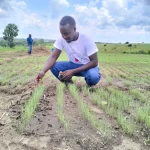kenthefarmer
Lister
When planting bulb onions, farmers can choose between two methods: direct seeding or starting with a nursery bed and later transplanting. Each method has its advantages and challenges. Let’s compare them to help you make the best choice for your farm.

Direct Seeding
This method involves planting onion seeds directly into the main field where they will grow until harvest.
Advantages:
-Saves labor and time since there is no transplanting.
-Avoids transplant shock, which can slow down plant growth.
-Ideal for large-scale farmers who want to reduce handling costs.
Disadvantages:
-Requires more seeds because some may fail to germinate.
-Harder to control weeds .
-Germination rate may be affected by poor soil conditions.
-Takes more time to sow seeds if using a system like drip irrigation, as each seed must be placed carefully.
-If seeds are scattered, plants may become overcrowded, leading to small, weak bulbs.
Nursery Bed and Transplanting
This method involves sowing seeds in a nursery, caring for the young plants, and then transplanting them to the main field after 6-8 weeks.
Advantages:
-Allows for better seedling management and care.
-Stronger and healthier seedlings are selected for transplanting.
-Saves space in the main field while preparing for planting.
-Uses smaller quantities of farm products such as fertilizers and pesticides since seedlings are concentrated in one place for about six weeks.
-Reduces labor, as spraying and weeding are easier when the plants are in a small area.
Disadvantages:
-Requires extra labor for transplanting.
-Seedlings may suffer from transplant shock.
-Growth delay can occur if not well managed.
For me, nursery beds and transplanting is the better option. It ensures strong seedlings, better spacing, and improved yields.
Regardless of the method you choose, you can use any irrigation system .drip irrigation, farrow , or rain hose to ensure proper water supply for better growth.
Choose the method that fits your farming conditions and resources. Whichever you pick, proper soil preparation, irrigation, and weed management will determine your success in bulb onion farming.
Happy farming!
~village investor
Direct Seeding
This method involves planting onion seeds directly into the main field where they will grow until harvest.
Advantages:
-Saves labor and time since there is no transplanting.
-Avoids transplant shock, which can slow down plant growth.
-Ideal for large-scale farmers who want to reduce handling costs.
Disadvantages:
-Requires more seeds because some may fail to germinate.
-Harder to control weeds .
-Germination rate may be affected by poor soil conditions.
-Takes more time to sow seeds if using a system like drip irrigation, as each seed must be placed carefully.
-If seeds are scattered, plants may become overcrowded, leading to small, weak bulbs.
Nursery Bed and Transplanting
This method involves sowing seeds in a nursery, caring for the young plants, and then transplanting them to the main field after 6-8 weeks.
Advantages:
-Allows for better seedling management and care.
-Stronger and healthier seedlings are selected for transplanting.
-Saves space in the main field while preparing for planting.
-Uses smaller quantities of farm products such as fertilizers and pesticides since seedlings are concentrated in one place for about six weeks.
-Reduces labor, as spraying and weeding are easier when the plants are in a small area.
Disadvantages:
-Requires extra labor for transplanting.
-Seedlings may suffer from transplant shock.
-Growth delay can occur if not well managed.
For me, nursery beds and transplanting is the better option. It ensures strong seedlings, better spacing, and improved yields.
Regardless of the method you choose, you can use any irrigation system .drip irrigation, farrow , or rain hose to ensure proper water supply for better growth.
Choose the method that fits your farming conditions and resources. Whichever you pick, proper soil preparation, irrigation, and weed management will determine your success in bulb onion farming.
Happy farming!
~village investor

